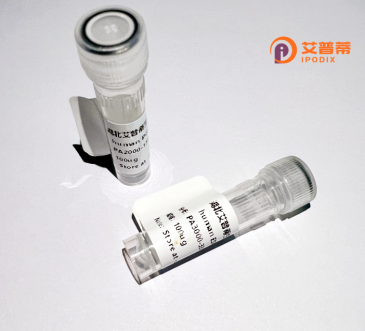
| 纯度 | >90%SDS-PAGE. |
| 种属 | Human |
| 靶点 | IMPACT |
| Uniprot No | Q9P2X3 |
| 内毒素 | < 0.01EU/μg |
| 表达宿主 | E.coli |
| 表达区间 | 1-320aa |
| 氨基酸序列 | MAEGDAGSDQRQNEEIEAMAAIYGEEWCVIDDCAKIFCIRISDDIDDPKWTLCLQVMLPNEYPGTAPPIYQLNAPWLKGQERADLSNSLEEIYIQNIGESILYLWVEKIRDVLIQKSQMTEPGPDVKKKTEEEDVECEDDLILACQPESSVKALDFDISETRTEVEVEELPPIDHGIPITDRRSTFQAHLAPVVCPKQVKMVLSKLYENKKIASATHNIYAYRIYCEDKQTFLQDCEDDGETAAGGRLLHLMEILNVKNVMVVVSRWYGGILLGPDRFKHINNCARNILVEKNYTNSPEESSKALGKNKKVRKDKKRNEH |
| 分子量 | 60.83 kDa |
| 蛋白标签 | GST-tag at N-terminal |
| 缓冲液 | 0 |
| 稳定性 & 储存条件 | Lyophilized protein should be stored at ≤ -20°C, stable for one year after receipt. Reconstituted protein solution can be stored at 2-8°C for 2-7 days. Aliquots of reconstituted samples are stable at ≤ -20°C for 3 months. |
| 复溶 | Always centrifuge tubes before opening.Do not mix by vortex or pipetting. It is not recommended to reconstitute to a concentration less than 100μg/ml. Dissolve the lyophilized protein in distilled water. Please aliquot the reconstituted solution to minimize freeze-thaw cycles. |
以下是关于重组人IMPACT蛋白的3篇代表性文献摘要概括:
---
1. **文献名称**:*Structural and functional characterization of the human IMPACT homolog, a modulator of translation initiation*
**作者**:Tcherkezian J, et al.
**摘要**:该研究解析了人源IMPACT蛋白的结构,揭示了其与酵母同源物Yih1的功能保守性。研究发现IMPACT通过结合真核起始因子eIF2调控蛋白质翻译,尤其在营养应激条件下拮抗GCN2激酶通路,维持翻译稳态。
2. **文献名称**:*Recombinant production of human IMPACT enhances neurite outgrowth via mTORC1 signaling in neuronal cells*
**作者**:Sousa-Neto A, et al.
**摘要**:利用大肠杆菌系统成功表达重组人IMPACT蛋白,并证明其可在神经元细胞中激活mTORC1信号通路,促进轴突生长。实验表明IMPACT通过调控氨基酸敏感性通路参与神经发育。
3. **文献名称**:*IMPACT knockdown impairs cell proliferation and sensitizes cancer cells to chemotherapy*
**作者**:Freire BL, et al.
**摘要**:通过重组IMPACT蛋白回补实验,验证其在维持细胞增殖中的作用。IMPACT缺失导致DNA损伤应答异常并增强化疗药物敏感性,提示其作为肿瘤治疗潜在靶点。
---
**说明**:IMPACT蛋白主要研究聚焦于其在翻译调控、神经发育及疾病中的作用,上述文献涵盖结构解析、功能验证及疾病模型应用。如需具体实验细节建议查阅原文。
Recombinant human IMPACT protein is a genetically engineered form of the endogenous IMPACT (Imprinted and Ancient Protein) encoded by the *IMPACT* gene. IMPACT is highly expressed in neurons and plays roles in regulating cellular stress responses, mRNA translation, and neuronal differentiation. It interacts with the GCN2 kinase, inhibiting its activity under amino acid starvation, thereby preventing phosphorylation of eIF2α and maintaining protein synthesis. This regulatory mechanism is critical for neuron survival under metabolic stress.
Structurally, IMPACT contains two conserved domains: an N-terminal YIH domain and a C-terminal SUZ domain, both implicated in protein-protein interactions. Recombinant IMPACT is typically produced in bacterial (e.g., *E. coli*) or mammalian expression systems, ensuring high purity and functionality for experimental use. Its applications span biochemical assays, structural studies, and investigations into neurodevelopmental or neurodegenerative pathways. Dysregulation of IMPACT has been linked to neurological disorders, including autism spectrum disorders and depression, making it a target for therapeutic research. Additionally, IMPACT's imprinted status—expressed exclusively from the paternal allele in certain tissues—underscores its role in epigenetic regulation. Studies leveraging recombinant IMPACT help elucidate its molecular interactions, stress-response mechanisms, and potential clinical relevance in brain health and disease.
×